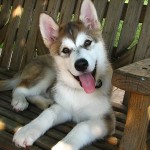Written by Senior Editor Peter Gehr
It’s commonly known that the Alaskan husky exercise with or without snow, and they love to run and run and work is simply an instinct, and in-built mechanism to work is part of the breeds makeup. In fact, most dog breeds love to be responsible for some form of work whether it be carrying, pulling, accompanying, guiding, performing and more.
The inner drive that dogs are born with is to please. They want so much to get your attention and to perform tasks, and this is what a lot of dog owners misunderstand, or do not provide, which can lead to behavioral problems and boredom.
A bored puppy will often become destructive, develop bad habits, become discontent and misbehave out of character, and this is all sourced back to mental and physical stimulation—which is vital to the well-being of your pet.
Alaskan Husky Exercise With or Without Snow
Consider the case of the Alaskan husky in this report below:
A warmer and drier than average winter is causing sled dog trainers to use off-season training techniques in lieu of sleds, according to Sno-Trek Sled Dog Adventures trainer Howard Thompson.
“Simply put we’re running on wheels. We’ve had a tradition for decades actually of preparing our dogs for the winter season by having them pull motor less four wheelers or ATV’s”.
Portion so Central Wisconsin have seen daytime temperatures nearly six degrees warmer than usual in January, and the region is more than 11 inches below normal snowfall levels. Those factors have led to little to no snow pack in areas of unusually snow-covered Wisconsin.
Even areas with snow do not have enough to allow sleds to be used to run the dogs.
Regardless of trail conditions, Thompson says his team of Alaskan Huskies maintains their fitness. His dogs are part of Sno-Trek Sled Dog Adventures, W573 US Highway 10, Mondovi. The team takes tourists for rides through the landscapes of east central Wisconsin.
“Alaskan Huskies are a breed of dog that has resulted from a lot of cross breeding of different breeds in Alaska during the Gold Rush around 1900. They hear better, smell better, and see things that we don’t see” Thompson said.
Thompson says that no matter what the conditions or weather is like, his dogs’ safety comes first.
“You always finish and leave gas in their tank. That’s how you develop trust. They know you’ll rest them before they need rest. You water and feed them before they need those things” he said. Click here to visit the original source of this post
Alaskan husky exercise with or without snow, and this story above shows how important it is for these dogs to know that they can exert and fulfill tasks that they love to do for both mental stimulation and that physical drive that’s bred into them. With the right care and attention the Alaskan husky develops a deep respect for their owner knowing that they are connected and cared for and given responsibility. This can also work for all breeds of dog, although obviously not all breeds are for pulling sleds, but it’s the work, the desire to please that can be used to keep dogs physically fit and given the opportunity to assist in some way—which is their natural yearning.



